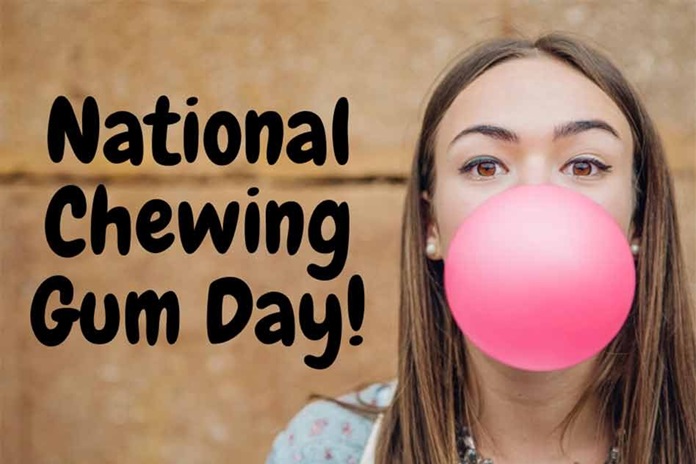National Chewing Gum Day is on September 30 each year. People everywhere enjoy chewing gum because of its chewy feel, the clear bubbles, and the fun pop sound. No matter what you call it-bubble gum, chewing gum, or chicle-there is nothing as enjoyable as chewing a piece of gum.
History of National Chewing Gum Day
Chewing gum might seem like a modern invention, but it has a long history. The oldest known piece of chewing gum, found in Kierikki, Finland in 2007, is 5,000 years old. This ancient gum was made from bark tar, which was thought to be antiseptic, and it even has visible teeth marks on it.
In Ancient Greece, people chewed mastic gum, which came from the resin of the mastic tree and was also believed to have antiseptic properties for oral health.
The Aztecs and Mayans chewed gum made from a substance called ‘chicle,’ and Native Americans used the sap from spruce trees. This history shows that various forms of chewing gum have been enjoyed by different civilizations for thousands of years.
Chewing gum became widely available in 1848 when John B. Curtis invented and sold a product called Maine Pure Spruce Gum. Then, in the 1860s, John Colgan made a big advance by creating the first flavored chewing gum.
Today, chewing gum is made with artificial ingredients like gum base, flavorings, colors, and sweeteners, unlike the early versions. Its wide range of colors and flavors makes it a fun treat and sugar-free gum even has oral health benefits.
Chewing helps reduce plaque and tooth decay by increasing saliva flow, which strengthens teeth and helps fight bad breath. This is great news for gum enthusiasts!
| 1848 (Commercial Chewing Gum) | Chewing gum was commercially produced and sold for the first time by John B. Curtis. |
| 1871 (Chewing Gum Machine) | Thomas Adams patents the first machine for making chewing gum. |
| 1939–1945 (Chewy Rations) | Chewing gum is given to World War II soldiers as part of their rations. |
| 1969 (Sugar-Free Gum) | Sugar-free gum hits the market. |
The Evolution of Chewing Gum
Over the years, chewing gum has evolved in both flavor and form. The early varieties were simple and often lacked the sweeteners and flavors that characterize modern gum. Today, the market offers a diverse range of gum flavors, from classic mint and fruity options to exotic and unconventional varieties.

In the 1960s and 70s, gum manufacturers began to experiment with different textures and functions, leading to the creation of sugar-free gum and gum designed to freshen breath or aid in dental health. Sugar-free gum, sweetened with sugar substitutes like sorbitol or xylitol, became a popular choice for those looking to reduce their sugar intake while still enjoying a tasty treat.
More recently, gum has seen innovations such as functional gum, which offers added benefits beyond just flavor. Some gums now include ingredients like caffeine, vitamins, or herbal extracts, targeting specific health or wellness needs.
Seven Interesting Facts About Chewing Gum
- Dental Benefits: Chewing gum can help your teeth. Sugar-free gum, in particular, can increase saliva production, which helps wash away food particles and neutralize acids in the mouth, reducing the risk of tooth decay and cavities.
- Stops Tears: Chewing gum while chopping onions can prevent your eyes from watering.
- Gum in Hair: If gum gets stuck in your hair, peanut butter can help remove it.
- Pink Gum: The first and only color available for chewing gum was pink!
- Boosts Focus, Memory, and Reduces Stress: Research shows that chewing gum can help lower stress, boost alertness, and improve memory.
- Enhances Oral Health: Chewing sugar-free gum benefits your oral health.
- Stress Relief: Chewing gum can act as a stress reliever. The repetitive motion of chewing can help reduce cortisol levels (a stress hormone) and promote relaxation. It’s a simple way to calm your nerves in stressful situations.
Conclusion
In conclusion, National Chewing Gum Day on September 30th celebrates more than just a fun and flavorful treat. From its ancient roots to its modern-day innovations, chewing gum has evolved significantly over thousands of years. Its historical journey—from early mastic gums in Ancient Greece to the invention of flavored gum and the introduction of sugar-free varieties—reflects its enduring popularity and versatility.
Today, chewing gum not only offers a wide range of flavors and textures but also provides notable benefits such as enhancing oral health, reducing stress, and improving focus. As you enjoy a piece of gum this September 30th, take a moment to appreciate the rich history and numerous advantages packed into each chew.
Frequently Ask Question
What is the history of chewing gum?
Chewing gum has a long history dating back thousands of years. The oldest known piece of gum, found in Finland, is 5,000 years old. Ancient Greeks chewed mastic gum, while the Aztecs and Mayans used chicle. In the 19th century, John B. Curtis commercialized chewing gum, and John Colgan introduced flavored gum.
How has chewing gum evolved?
Initially, chewing gum was simple and lacked modern sweeteners and flavors. Today, it comes in a diverse range of flavors and textures, including sugar-free varieties that offer additional dental benefits. Recent innovations include functional gums with added ingredients like caffeine or vitamins.
What are some interesting facts about chewing gum?
Chewing gum can benefit dental health by increasing saliva flow. It can help stop tears while chopping onions, and peanut butter can remove gum from hair. The first chewing gum was only available in pink. Chewing gum can also boost focus, and memory, and reduce stress.
What are the benefits of chewing sugar-free gum?
Sugar-free gum helps improve oral health by increasing saliva production, which washes away food particles and neutralizes acids, reducing the risk of tooth decay and cavities.
Also read, National Cinnamon Roll Day – October 4, 2024
